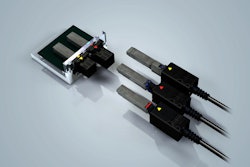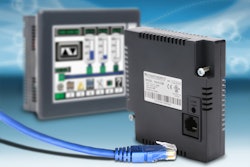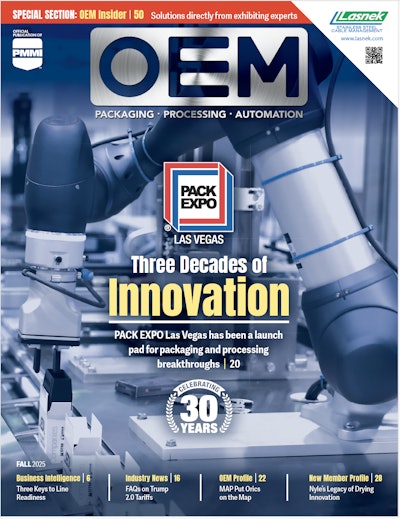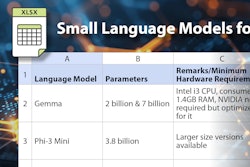Approximately three years ago, AIM was approached by a leading home improvement retailer to help expand their distribution facilities with an AGV system tailored for each of their new storage and shipping centers. The company had very detailed requirements, specifying their own preferred mechanical platform, and they asked AIM to apply an automated guidance system to this existing platform. Traditional AGV automation systems lacked the flexibility and robust operation necessary to accomplish this task, leading AIM to think outside the box and ultimately seek out a PC-based control system from Beckhoff.
Emerging from these demands is the newest iteration of AGVs at AIM: the iBOT series. It leverages both Kalman filters and odometry for navigation, as well as the Dijkstra algorithm, a mathematical process for finding the shortest path between two points. Instead of leveraging a proprietary, AGV-specific control system, AIM uses standard PC-based control technology to equip these vehicles with modern path-planning functionality, similar to any number of navigation apps used on smartphones. The advanced iBOT series is growing in popularity and, in just one example, has found a home with this large home-improvement retailer, working in the company’s distribution facilities by moving pallets of stock keeping units (SKUs) to locations throughout the facility for storage or outbound shipping. These AGVs implement all the typical functions of a forklift, such as forward motion, steering, and mast control.
For this application, AIM has engineered an entire fleet of what are essentially automated robotic forklifts, shunting SKUs to various stations within a gigantic distribution facility. Each AGV is totally autonomous, carrying out instructions with minimal operator input, helping to streamline distribution center operations and create numerous efficiencies.
This is deceptively simple, as the nature of the pallets varies from operation to operation. Tommy Hessler, the CEO of AIM, explains: “As you can imagine, people don’t buy a whole pallet’s worth of products. Each pallet contains a mix of products, so the size and weight of each pallet is constantly changing. The vehicle picks up the packed pallet and drives it to one of several stretch wrappers and drops it off, all while automatically avoiding warehouse shelves, human workers, and the seven other AGVs.”
The scale of the project was daunting. The 1,200 foot long warehouse necessitated mapping of thousands of positions, and the system has to track order numbers and individual products on the pallets, all while relaying this information back to the central computer for collection and monitoring. Complicating matters further, the fleet of AGVs receives around 80 orders at a time, so it is important to optimize the operation of the AGVs by minimizing distances and travel times, which also ensures error-free operation.
For much of AGV history, a dedicated, hard-coded system running some sort of path-planning algorithm provided the motion control of the robotic system. Due to the hard-wired nature of the controls and the complexity of the system in general, programming and commissioning these vehicles was a time- and labor-intensive process – in addition to being costly and difficult for end user personnel to troubleshoot in the event of an error or other system issue.
“You can view an AGV just like any piece of equipment, as each consists of 3 different component categories: mechanics, electrical wiring, and electronic controls with software,” says Hessler. “Most end users have the experience to address any mechanical or electrical issues on an AGV, but when it comes to the controls and the software, they are often boxed in and have no choice but to rely on a single source vendor for support.” This makes an AGV system a less attractive option for many users, as their operation will be dependent on a single vendor. Hessler continues: “With the iBOT series, we now have an AGV based on a PLC system from Beckhoff that breaks down that barrier. Suddenly, an AGV can be supported just like a traditional PLC system with standard parts, enabling easy replacement of components.”
As stated earlier, AIM chose a different path and implemented a PC-based control system in their iBOT series, in this case Beckhoff CP6606-0001-0020 Panel PCs running TwinCAT software. The Beckhoff systems enable AIM to program PLC functionality in software, effectively creating a PLC in software while being able to integrate numerous other features into the Windows system. A step up from the previous version utilizing a separate control panel and Embedded PC, the new system features an integrated Panel PC that provides all the necessary processing power in the iBOT systems. The robust device features a 1 GHz ARM Cortex™-A8 CPU, Windows Embedded Compact 7 operating system, 1GB of RAM, fanless operation, and no rotating components, ensuring reliability for this demanding application. The Panel PC is integrated directly on the AGV, adeptly handling display of the human-machine interface (HMI) for the iBOT system and reducing control component count as a result.
In addition, four stationary display panels, in this case 19-inch Stainless Steel, IP 65-rated CP7703 Panel PCs, are mounted at various locations around the home improvement retailer’s distribution facility. Each device displays the positions and traffic statistics of the eight AGVs and tracks performance, loads per hour, and any errors or performance inadequacies.
Traditional onboard navigational systems use laser sensors and an algorithm to determine X, Y and T (angle) of the vehicle in relation to obstacles in a warehouse. Through the Beckhoff TwinCAT automation platform running on the Embedded PC, this functionality can be accomplished in software and carried out in real-time via the EtherCAT industrial Ethernet system. TwinCAT 2 currently provides the programming environment and runtime for the automation system, enabling PLC functions in software and adding a measure of accessibility to the system, given the user-friendly nature of the software. TwinCAT TCP/IP server provides a layer of communication between the AGVs and the end users’ corporate networks and facilitates communication between the controller and the onboard third party navigational system components. The processes handled by the controller are especially time critical, as the navigation system needs to know where the vehicle is at all times to avoid potential crashes and damaged product.
A selection of EtherCAT I/O terminals provides lightning-fast onboard communication for the AGVs. Hessler discusses the advantages of this increase in speed: “EtherCAT is hands down the fastest communication system we have ever encountered. Relaying instructions to the navigation system while maintaining low latency requires a robust, high-throughput method of transmission, and EtherCAT is tops when it comes to speed. This system, in conjunction with the easy installation and configuration enabled by TwinCAT software, helped us create a superb end result.”
The I/O system also provides flexibility in communication to non-EtherCAT devices via EL6751 CANopen terminals and EL6021 RS422 terminals, which serve as interfaces for routing back to the navigation controller. In addition, an EL6224 IO-Link terminal provides communication for height sensors on the AGV forklift mast. “Precision is key for the height sensors, given the nature of the application,” said Hessler. “For example, say the tines of a fork need to travel over a height of 30 feet to reach a pallet located on a shelf. Misalignment of only one or two percent is enough to miss the pallet entirely, which is completely unacceptable in a time-critical application such as this. We tried several alternative options, but IO-Link components from Beckhoff remain the easiest way to remove any noise or faulty information from the operation.”
The iBOT series AGVs also monitor the onboard battery, offering an automatic “quick charge” system that can replenish the battery in just 6 minutes after an hour of running. This results in an exceptionally energy-efficient solution that enables AGVs to provide 24/7 service in any plant without any operator intervention.
The over-arching goal for this project, and for the iBOT AGV series as a whole, according to Hessler, was to eliminate the dependence of AGV customers on a single vendor, freeing them from the limitations of proprietary controls and allowing them to seek out support wherever they choose. Said Hessler, “This is a huge step forward to position the AGV as a mainstream material handling and logistics solution. By removing a significant portion of the cost and by making the programming much more accessible, more customers accept highly automated systems, thereby growing our business.”
By leveraging this new PC-based control architecture, AIM was able to slash around 40 percent off the cost of a traditional PLC-based AGV control system. According to Hessler, this is primarily a function of the economies of scale. “Traditionally, AGV control system volumes are relatively low, often around 100 or so orders for any series, making each unit much more expensive. We reduced our costs dramatically by moving to a standard system with PC-based hardware and an economical automation software platform like TwinCAT ̶ savings we pass along to our customers,” says Hessler.
Hessler notes that AIM is fully onboard with the PC-based control philosophy, as it is the standard platform for every AGV and AGC (automatic guided cart) the company manufactures. AIM also intends to further advance the PC- and EtherCAT-based platforms in future AGV and AGC offerings. “There is still incredible potential with the PC Control platform and with the ability to program path-planning and PLC functionality in software,” he says. “We have several new projects in the works with large customers that will also feature the iBOT system, and look forward to continuing our progress with the PC-based platform in these applications.”





















